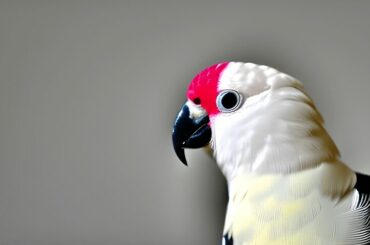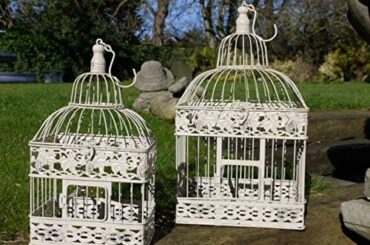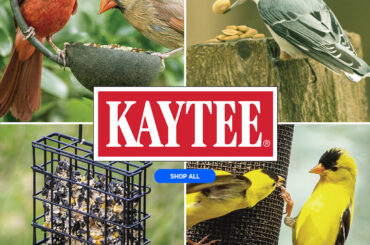Table of Contents
Introduction to the Blue Eclectus Parrot
The Blue Eclectus Parrot is a truly magnificent bird that captivates all who see it. With its vibrant plumage and unique characteristics, this species stands out in the avian world. Understanding its habitat and natural distribution further enhances our appreciation for this enchanting creature.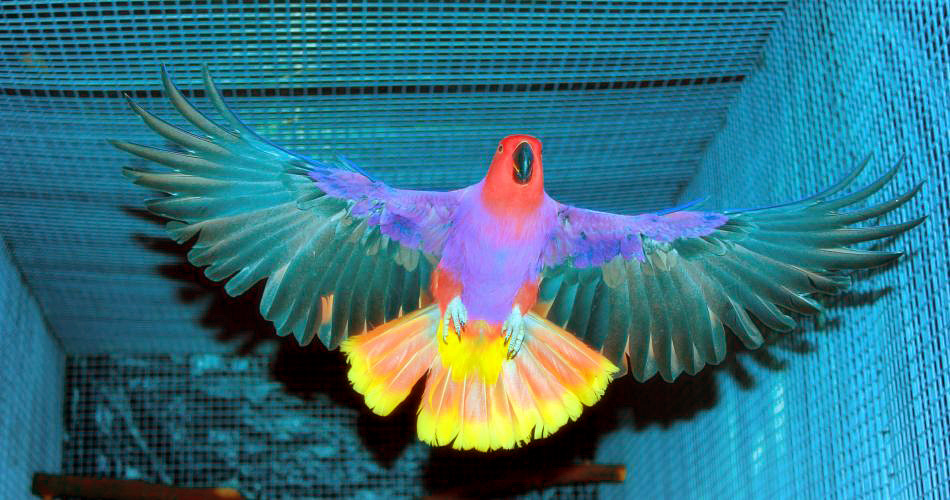
An overview of the Blue Eclectus Parrot’s unique characteristics
The Blue Eclectus Parrot is known for its stunningly vivid and diverse feather colors. The males display a striking blue coloration, while the females enchant with their captivating green and red appearance. This stark contrast between the sexes makes them one of the most visually intriguing bird species.
Understanding the habitat and natural distribution of the species
Blue Eclectus Parrots are native to the rainforests of the Solomon Islands, New Guinea, northeastern Australia, and nearby islands. These lush habitats provide the perfect environment for the parrots to thrive and showcase their exceptional beauty. The species prefers dense tropical forests, where they can find ample food sources and nesting sites.
The Fascinating Blue Eclectus Feather Coloration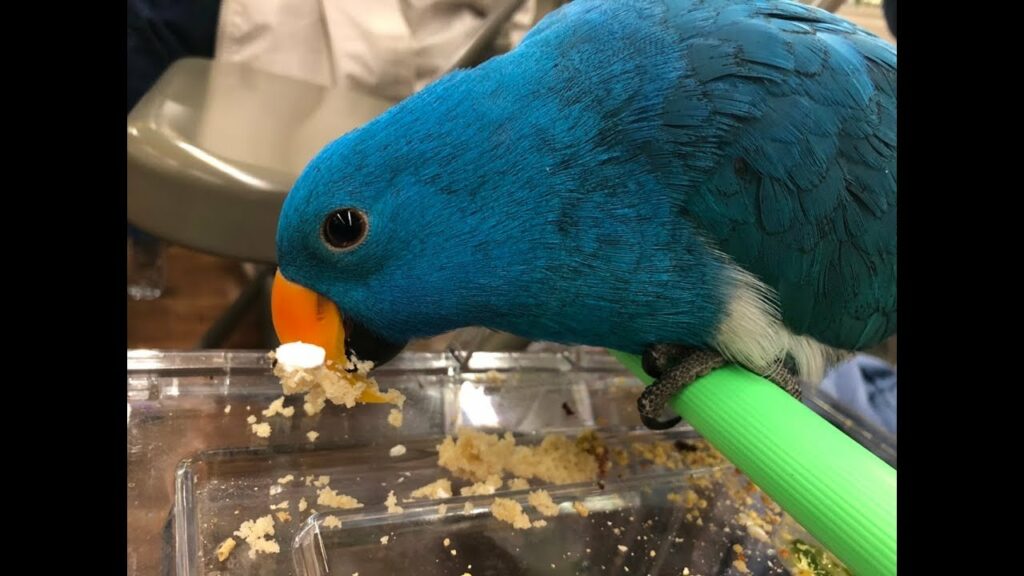
The feather coloration of these Bird Species is truly a sight to behold. Let’s take a closer look at the mesmerizing colors displayed by both male and female parrots.
A closer look at the striking blue plumage of the male Blue Eclectus Parrot
The male Blue Eclectus Parrot boasts a stunning cobalt-blue color that spans across its body. The intensity and vibrancy of this blue hue are truly awe-inspiring. Their feathers reflect light in such a way that the parrots appear to be glowing, creating a captivating visual display.
Exploring the captivating green and red appearance of the female Blue Eclectus Parrot
In contrast to the males, female Blue Eclectus Parrots exhibit a striking combination of vibrant green and contrasting red feathers. This unique coloration not only serves as a distinct identifier but also adds to the overall allure and beauty of the species. The green feathers blend seamlessly with the foliage, providing the females with enhanced camouflage in their natural habitat.
Evolutionary Advantages of Vibrant Plumage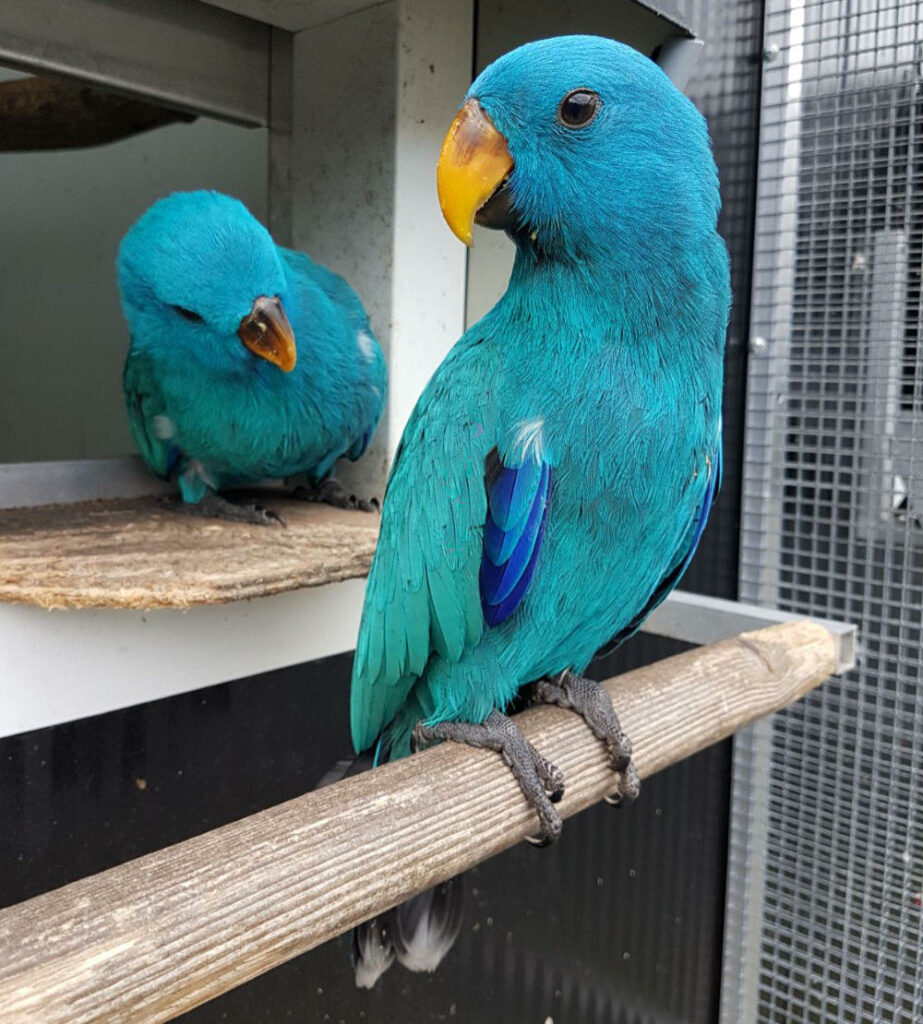
The exceptional colors of the Bird Species serve a crucial purpose beyond mere visual appeal. Let’s explore the possible reasons behind their vibrant plumage.
Investigating the possible reasons behind the Blue Eclectus Parrot’s exceptional colors
The evolutionary advantages of the Blue Eclectus Parrot’s vibrant plumage are manifold. The striking colors may serve as a form of communication, allowing them to convey messages to others in their population. Additionally, the bright plumage may provide a form of protection, as predators are deterred by their conspicuous appearance.
Understanding the role of display in attracting mates and establishing territory
Vibrant plumage plays a crucial role in attracting mates and establishing territory within the Blue Eclectus Parrot community. The males’ brilliant blue coloration functions as a display of health and genetic fitness, attracting potential female partners. Similarly, the females’ vivid green and red feathers signal their readiness for mating and can help them establish their own territories.
Anatomy and Physical Attributes of the Blue Eclectus Parrot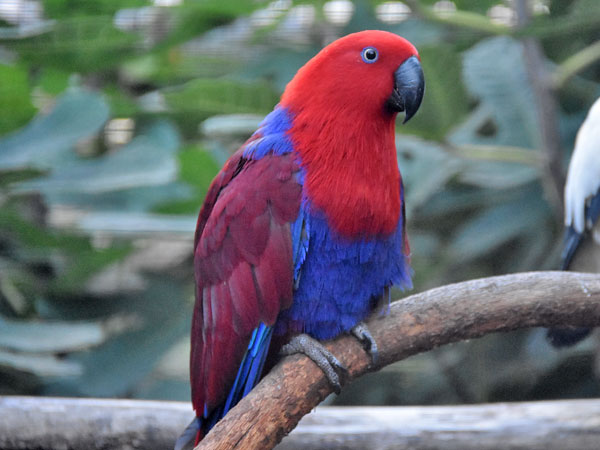
This Bird Species possesses unique physical attributes that contribute to its charm. Let’s delve into the intricacies of their beaks, talons, and wings.
Examining the distinctive beak shape and size of the Blue Eclectus Parrot
The Bird Species has a sturdy, curved beak that is perfectly adapted for reaching and cracking open various types of nuts and seeds found in their natural habitat. The beak’s structure enables them to feed efficiently, ensuring they have a constant source of nourishment.
Analyzing the proportions and features of their talons and wings
The Blue Eclectus Parrot’s talons are sharp and powerful, providing them with a strong grip on tree branches and enabling them to navigate their dense forest home with ease. Their wings are strong and broad, allowing for agile flight through the dense foliage. These physical attributes make them well-suited for their natural environment.
Natural Behavior and Social Structure
This Bird Species exhibit fascinating behaviors and possess a unique social structure that contributes to their overall appeal. Let’s explore their social dynamics and mating rituals.
Highlighting the social structure and hierarchy within Blue Eclectus Parrot communities
Within Blue Eclectus Parrot communities, a clear social structure and hierarchy exist. They live in small groups, usually consisting of a dominant breeding pair and their offspring. The dominant pair holds the highest social status within the group, and the others respect their authority.
Unveiling the intriguing mating rituals and courtship behaviors of the species
During mating season, male Blue Eclectus Parrots display elaborate courtship behaviors to captivate female partners. They engage in flamboyant displays, showcasing their vibrant plumage while engaging in intricate dances and vocalizations. These rituals not only strengthen the bond between mates but also serve as an important aspect of the species’ reproductive success.
Diet and Foraging Patterns
The Bird Species diet and foraging patterns play a significant role in their survival and overall well-being. Understanding their dietary preferences and foraging techniques provides valuable insights into their ecological niche.
Understanding the Blue Eclectus Parrot’s dietary preferences in the wild
Blue Eclectus Parrots are primarily herbivorous, consuming a variety of fruits, seeds, flowers, and nuts. They have a particular affinity for the fruit of the palm tree. Their specialized beak and digestive system are well-adapted for efficiently extracting nutrients from these food sources. The parrots’ dietary preferences contribute to the dispersal of plant seeds, making them essential for maintaining forest ecosystems.
Exploring their foraging techniques and adaptability to various food sources
Blue Eclectus Parrots have a versatile foraging style that allows them to adapt to different food sources depending on what is available in their environment. They utilize their strong beaks to crack open hard nuts and fruits, showing incredible dexterity and precision. Their adaptability ensures their survival even in challenging conditions.
Breeding Habits and Nesting Strategies
The reproductive behaviors and nesting habits of these Bird Species are a testament to their evolutionary adaptability. Let’s delve into their breeding habits and the roles of male and female parrots in raising offspring.
Investigating the nesting habits and preferences of the Blue Eclectus Parrot
Blue Eclectus Parrots are cavity nesters, meaning they choose suitable hollow spaces within trees for nesting. The females are responsible for selecting and preparing the nest site, while the males defend the territory. The nesting cavities provide protection for the eggs and hatchlings, ensuring the survival of the next generation.
Understanding the role of male and female parrots in breeding and raising offspring
The breeding process among Blue Eclectus Parrots involves the male and female parrots engaging in a cooperative effort. Once the eggs are laid, the female incubates them while the male provides protection and food. After hatching, both parents actively participate in feeding and caring for the chicks until they fledge. This shared responsibility enhances the success of their breeding efforts.
Vocalizations and Communication
Communication is a vital aspect of Blue Eclectus Parrot society. Through their vocal repertoire and unique displays, these birds convey crucial messages and establish social bonds.
Analyzing the vocal repertoire and communication methods of Blue Eclectus Parrots
Blue Eclectus Parrots possess a wide range of vocalizations, ranging from soft chirps to loud squawks. They use these vocalizations to communicate with other members of their group, as well as to convey their intentions and warnings. These vocalizations play a significant role in maintaining social cohesion within the flock.
Decoding the meaning behind different calls, squawks, and vocal displays
Each call, squawk, or vocal display of Blue Eclectus Parrots carries a specific meaning. They use distinct vocalizations to communicate various messages, including announcing their presence, signaling danger, expressing aggression, and attracting mates. Experienced observers can decipher these sounds to gain a deeper understanding of their behaviors and needs.
Threats to the Blue Eclectus Parrot Population
Blue Eclectus Parrots face numerous threats that put their survival at risk. Their vulnerability to these threats necessitates a concerted effort to preserve their population.
Discussing the primary threats faced by the Blue Eclectus Parrot in their natural habitat
The primary threats to these Bird Species population include deforestation, habitat loss, and degradation due to human activities, such as land clearance for agriculture and logging. These activities disrupt their natural habitat and reduce their food sources, leading to a decline in their numbers.
Examining the impact of deforestation, illegal trade, and climate change on their survival
Deforestation and habitat loss not only diminish the available resources for the Blue Eclectus Parrot but also expose them to increased predation and competition for limited resources. Additionally, illegal trade poses a significant threat, as these birds are highly sought after in the exotic pet market. Climate change further exacerbates these challenges, affecting their breeding patterns, food availability, and overall health.
Conservation Efforts and Success Stories
Various organizations and initiatives are dedicated to the conservation of Blue Eclectus Parrots. Through their efforts, they aim to protect these magnificent creatures and ensure their survival for future generations.
Shedding light on organizations and initiatives working towards Blue Eclectus Parrot conservation
Numerous organizations, both local and international, are actively involved in Blue Eclectus Parrot conservation. They work tirelessly to protect the bird’s natural habitats, raise awareness about their plight, and implement strategies for sustainable development in the areas they inhabit.
Highlighting successful case studies of habitat restoration and captive breeding programs
There have been success stories in habitat restoration and captive breeding programs for the Blue Eclectus Parrot. By reintroducing the parrots to restored and protected habitats, populations have been able to rebound. Additionally, captive breeding programs have helped mitigate the impact of illegal trade and provide individuals for future reintroduction efforts.
Blue Eclectus Parrots in Captivity
The Blue Eclectus Parrot’s unique beauty and captivating personality have made it a popular choice as an exotic pet. However, their proper care and husbandry require a deep understanding of their unique needs.
Exploring the popularity of Blue Eclectus Parrots as exotic pets
Blue Eclectus Parrots have gained popularity as exotic pets due to their stunning appearance and remarkable intelligence. Their ability to mimic human speech and their adaptability to captivity make them sought after companions.
Understanding the proper care and husbandry requirements for captive Blue Eclectus Parrots
Caring for captive Blue Eclectus Parrots involves providing them with a balanced diet that mimics their natural food sources, as well as spacious and enriched enclosures that mimic their natural habitat. Regular veterinarian check-ups, socialization, mental stimulation, and ample exercise are crucial for their well-being.
Challenges and Responsibilities of Blue Eclectus Parrot Ownership
Owning a Blue Eclectus Parrot comes with unique challenges and responsibilities that should be thoroughly considered before making the commitment.
Discussing the potential challenges and considerations for prospective Blue Eclectus Parrot owners
Prospective Bird Species owners must consider the long-term commitment required to provide proper care for these birds. They have specific dietary and social needs that must be met, as well as the need for mental stimulation. Their lifespan can exceed 30 years, meaning owners must be prepared to provide constant care and attention.
Emphasizing the significance of responsible pet ownership and ethical breeding practices
Responsible pet ownership is paramount for Blue Eclectus Parrots’ overall well-being. This includes obtaining birds from reputable breeders who prioritize the health and genetic diversity of the species. Additionally, owners must provide a nurturing and stimulating environment and be willing to commit to the bird’s lifelong care.
Myths and Misconceptions about Blue Eclectus Parrots
There are several myths and misconceptions surrounding the Bird Species. Let’s debunk some of these misunderstandings to promote a better understanding of these beautiful birds.
Debunking common myths surrounding the Blue Eclectus Parrot species
One common myth is that Blue Eclectus Parrots are aggressive and difficult to handle. In reality, their behavior varies from individual to individual, and with proper socialization and consistent training, they can become affectionate and gentle companions.
Clarifying misconceptions regarding their behavior, lifespan, and care
Another misconception is that Blue Eclectus Parrots require less social interaction and mental stimulation compared to other parrot species. In fact, they thrive on socialization and intellectual challenges, and neglecting these crucial aspects can result in boredom and health issues. Additionally, their lifespan can surpass three decades with proper care, contrary to the belief that they have a shorter lifespan.
Unique Personalities and Bonding with Blue Eclectus Parrots
Each of these Bird Species has its own unique personality, making them fascinating and rewarding companions. Building a strong bond with these birds requires understanding and patience.
Exploring the individual personalities and quirks displayed by Blue Eclectus Parrots
Blue Eclectus Parrots exhibit a wide range of personalities, ranging from outgoing and playful to shy and reserved. Some may have specific quirks or preferences, such as enjoying particular toys or showing affinity for certain individuals. Understanding and accommodating these idiosyncrasies strengthens the bond between the birds and their owners.
Understanding the potential for bonding and forming strong relationships with these parrots
Blue Eclectus Parrots are highly intelligent and form strong bonds with their human companions. Developing a relationship based on trust, mutual respect, and positive reinforcement is key to cultivating a lifelong friendship. Spending quality time together, providing enrichment, and engaging in interactive play ensures a deep and meaningful bond.
XV. Training and Enrichment for Blue Eclectus Parrots
When it comes to training and enrichment for Blue Eclectus Parrots, there are several effective techniques that can be utilized to ensure their mental stimulation and overall wellbeing. These intelligent and sociable birds thrive in an environment that provides them with both physical and mental challenges.
Discussing effective training techniques and enrichment activities for mental stimulation
- Clicker Training: One popular method for training Blue Eclectus Parrots is clicker training. This positive reinforcement technique involves using a clicker to mark desired behaviors followed by rewards, such as treats or praise. Clicker training helps establish a strong bond between the parrot and its owner while teaching them new tricks and commands.
- Target Training: Target training is an essential aspect of clicker training. By utilizing a target stick or your hand as a target, you can encourage your Bird Species to follow and interact with the target. This helps in teaching them to step up, fly to specific locations, and perform other commands.
- Puzzle Toys and Foraging: Blue Eclectus Parrots are known for their problem-solving abilities, and providing them with puzzle toys and foraging activities can keep their minds engaged. Puzzle toys may include hidden treats that need to be discovered, while foraging activities involve hiding food around their enclosure for them to find and enjoy.
- Treat Balls: Treat balls are excellent puzzle toys that encourage your parrot to work for their food. These balls have openings that release treats as the parrot rolls or interacts with them. This engages their natural foraging instincts and provides mental stimulation.
- Socialization: Blue Eclectus Parrots are highly social birds and require regular interaction with their human companions or other parrots. Socialization helps to prevent boredom and loneliness, reducing the risk of behavioral issues. Regular playtime, training sessions, and supervised interactions with other well-mannered birds can contribute to their overall mental enrichment.
Highlighting the importance of positive reinforcement and socialization
Positive reinforcement is crucial when training Blue Eclectus Parrots, as it helps to build trust and strengthen the bond between you and your feathered friend. This approach focuses on rewarding desired behaviors rather than punishing unwanted ones.
By using treats, verbal praise, and physical affection, you can positively reinforce behaviors such as stepping up, speaking on command, or even performing tricks. This not only motivates your parrot but also creates a positive association with training sessions.
Socialization plays a vital role in the development and well-being of Blue Eclectus Parrots. Exposing them to different environments, stimuli, and experiences from an early age helps them become more adaptable and confident. It is important to introduce them to new people, animals, and situations gradually, ensuring positive and supervised interactions.
Blue Eclectus Parrot Health and Common Medical Issues
While Blue Eclectus Parrots are generally hardy birds, they are prone to a few specific health concerns that owners should be aware of. Regular veterinary check-ups, coupled with preventive care, can help ensure their overall health and wellbeing.
Identifying potential health concerns specific to Blue Eclectus Parrots
- Feather Plucking: Feather plucking is a common issue among Blue Eclectus Parrots, which may arise due to various reasons such as stress, boredom, or medical conditions. Regular health check-ups can help identify potential underlying causes and address the problem promptly.
- Proper Diet: A healthy diet is essential in preventing feather plucking. Bird Species require a balanced mix of fresh fruits, vegetables, seeds, and pellets to meet their nutritional needs. Vitamin and mineral supplements may be recommended by your avian veterinarian to support optimal feather health.
- Psittacine Beak and Feather Disease (PBFD): PBFD is a viral infection that can affect Blue Eclectus Parrots, leading to feather abnormalities, beak deformities, weight loss, and a weakened immune system. Regular testing for PBFD is necessary to catch any potential cases early on.
Providing insights on regular veterinary check-ups and preventive care
Regular veterinary check-ups are crucial to maintaining the health of your Eclectus Bird Species. An avian veterinarian will perform a thorough examination, including a physical check-up, blood work, and possibly testing for specific diseases or infections.
Preventive care for Blue Eclectus Parrots involves:
- Establishing a relationship with an avian veterinarian who specializes in exotic bird care.
- Maintaining a clean and hygienic environment to prevent the spread of diseases.
- Providing a well-balanced diet and fresh water daily.
- Regularly trimming the parrot’s beak and nails.
- Ensuring proper hygiene and grooming practices.
By adhering to these preventive care measures and seeking prompt veterinary attention when necessary, you can help ensure your Bird Species leads a long, healthy, and vibrant life.
Tips for Photographing the Blue Eclectus Parrot
Capturing stunning photographs of Blue Eclectus Parrots can be both challenging and rewarding. These vibrant and colorful birds deserve to be showcased in all their glory. Here are a few tips and techniques to help you take memorable photographs of these fascinating creatures.
Offering helpful tips and techniques to capture stunning photographs of these birds
- Lighting: Adequate lighting is essential for capturing the true colors and details of the Blue Eclectus Parrot. Natural light is often the best option, providing a soft and flattering illumination. Avoid using flash, as it can startle or harm the bird.
- Backlighting: Experiment with backlighting techniques, where the light source is positioned behind the bird, creating a beautiful halo effect around its feathers.
- Composition: Pay attention to composition to create visually appealing photographs. Consider the rule of thirds by placing the parrot off-center, utilize leading lines to draw attention to the subject, or experiment with different angles and perspectives.
- Environmental Portraits: Incorporate the bird’s natural surroundings, such as trees or flowers, to add depth and context to your photographs. This creates more captivating and unique shots.
- Patience and Timing: Blue Eclectus Parrots have their own rhythms and behaviors. Patience is key when photographing them. Observe their movements and wait for the perfect moment to capture their natural gestures and expressions.
Focusing on lighting, composition, and showcasing their vibrant colors
Lighting and composition play crucial roles in highlighting the vibrant colors of the Bird Species. By utilizing natural light and careful composition techniques, you can create visually stunning photographs that capture the true essence of these remarkable birds.
Remember that each parrot is unique, and their colors may vary slightly. Adjust your camera settings to accurately represent their hues, and experiment with different angles and lighting conditions to showcase the full spectrum of their brilliance.
Blue Eclectus Parrots in Art, Literature, and Culture
Blue Eclectus Parrots have a long-standing history of fascination and admiration across various cultures, art forms, and literature. These magnificent creatures have captured the imagination of humans for centuries, leaving an indelible mark on our creative expressions.
Tracing the historical and cultural significance of Blue Eclectus Parrots
- Indigenous Significance: Blue Eclectus Parrots hold deep cultural significance in their native habitats. They are revered in some indigenous folklore, representing beauty, wisdom, and spirituality.
- Spiritual Beliefs: Some cultures consider Blue Eclectus Parrots as divine messengers or symbols of good luck, prosperity, and harmony.
- Artistic Representation: Throughout history, Blue Eclectus Parrots have been depicted in various forms of art, including paintings, ceramics, and tapestries. Their vibrant colors and unique features have inspired painters, sculptors, and artisans worldwide.
Exploring their representation in art, literature, and indigenous folklore
- Art: From classical paintings to modern sculptures, Blue Eclectus Parrots have been a favorite subject for artists worldwide. Their brilliant plumage and captivating presence make them ideal models to capture on canvas or in other art forms.
- Exotic Artifacts: Intricate carvings, jewelry, and decorative objects often incorporate Bird Species motifs, symbolizing beauty, majesty, and creativity.
- Literature: Blue Eclectus Parrots have found their way into the imagination of authors, poets, and storytellers. They are often used as metaphors for elegance, freedom, or as emblematic characters in literary works.
- Children’s Books: Blue Eclectus Parrots frequently star in children’s books, captivating young readers with their vibrant appearance and adventurous tales.
Summary: Celebrating the Beauty of Nature’s Colorful Masterpiece
The Blue Eclectus truly deserves the title of “Nature’s Colorful Masterpiece.” From their stunning plumage to their intelligent and sociable nature, these enchanting birds have captivated humans throughout history. In summary:
- Training and enrichment activities are essential for the mental stimulation and overall wellbeing of Blue Eclectus Parrots.
- Regular veterinary check-ups and preventive care help maintain their health and prevent common medical issues.
- Capturing memorable photographs of Blue Eclectus Parrots requires attention to lighting, composition, and showcasing their vibrant colors.
- Their historical and cultural significance can be traced through various art forms, literature, and indigenous folklore.
- Preserving the species is crucial for future generations to continue marveling at the beauty of these remarkable creatures.
READ ALSO:
- The Surefire Way to Find the Best Parakeet Food! – Tweet, Eat, Repeat: Transforming Ordinary Meals into Extraordinary Feasts
- Breathtakingly Brilliant: Meet the Military Macaw, the Colorful Jewel of the Jungle
- The Ultimate Guide to Finding the Best Parakeet Food Near You
- Zupreem Parakeet Food: The Deliciously Nutritious Way to Show Your Feathered Friend Some Love
- The Shocking Truth: Can Cockatiels eat Parakeet Food? Unveiling the Ultimate BFF’s Dietary Secrets!
- The Ultimate Guide to Creating Nutritious Parakeet Food – Unveiling the Secret Recipe
- Unveiling the Ultimate Guide: Jenday Conure Price Revealed for All Bird Lovers!
- Jenday Conure for Sale: Unlock the Door to Joy and Endless Entertainment
XX. Frequently Asked Questions (FAQs)
Here are answers to commonly asked questions about the Blue Eclectus Parrot’s care, behavior, and conservation:
Q: What should I feed my Blue Eclectus Parrot?
- A: Blue Eclectus Parrots require a varied diet comprising fresh fruits, vegetables, seeds, and specially formulated pellets. Consult with an avian veterinarian for specific dietary recommendations.
Q: Can Blue Eclectus Parrots talk?
- A: Blue Eclectus Parrots are known for their exceptional talking abilities. With proper training and socialization, they can learn a wide range of words and phrases.
Q: How long do Blue Eclectus Parrots live?
- A: Blue Eclectus Parrots have an average lifespan of 30 to 50 years, but with attentive care, some individuals have been known to live up to 70 years.
Remember, the more we learn about these magnificent birds, the better equipped we are to provide them with the care and love they deserve. Let’s celebrate the beauty of the Blue Eclectus Parrot and work towards preserving their species for generations to come.

